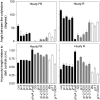GIGANTEA regulates phytochrome A-mediated photomorphogenesis independently of its role in the circadian clock
- PMID: 17384162
- PMCID: PMC1913770
- DOI: 10.1104/pp.107.097048
GIGANTEA regulates phytochrome A-mediated photomorphogenesis independently of its role in the circadian clock
Abstract
GIGANTEA (GI) is a nuclear protein involved in the promotion of flowering by long days, in light input to the circadian clock, and in seedling photomorphogenesis under continuous red light but not far-red light (FR). Here, we report that in Arabidopsis (Arabidopsis thaliana) different alleles of gi have defects in the hypocotyl-growth and cotyledon-unfolding responses to hourly pulses of FR, a treatment perceived by phytochrome A (phyA). This phenotype is rescued by overexpression of GI. The very-low-fluence response of seed germination was also reduced in gi. Since the circadian clock modulates many light responses, we investigated whether these gi phenotypes were due to alterations in the circadian system or light signaling per se. In experiments where FR pulses were given to dark-incubated seeds or seedlings at different times of the day, gi showed reduced seed germination, cotyledon unfolding, and activity of a luciferase reporter fused to the promoter of a chlorophyll a/b-binding protein gene; however, rhythmic sensitivity was normal in these plants. We conclude that while GI does not affect the high-irradiance responses of phyA, it does affect phyA-mediated very-low-fluence responses via mechanisms that do not obviously involve its circadian functions.
Figures






Similar articles
-
GIGANTEA acts in blue light signaling and has biochemically separable roles in circadian clock and flowering time regulation.Plant Physiol. 2007 Jan;143(1):473-86. doi: 10.1104/pp.106.088757. Epub 2006 Nov 10. Plant Physiol. 2007. PMID: 17098855 Free PMC article.
-
CP3 is involved in negative regulation of phytochrome A signalling in Arabidopsis.Planta. 2002 Aug;215(4):557-64. doi: 10.1007/s00425-002-0784-7. Epub 2002 May 21. Planta. 2002. PMID: 12172837
-
SPINDLY and GIGANTEA interact and act in Arabidopsis thaliana pathways involved in light responses, flowering, and rhythms in cotyledon movements.Plant Cell. 2004 Jun;16(6):1550-63. doi: 10.1105/tpc.019224. Epub 2004 May 21. Plant Cell. 2004. PMID: 15155885 Free PMC article.
-
Shedding (far-red) light on phytochrome mechanisms and responses in land plants.Plant Sci. 2014 Mar;217-218:36-46. doi: 10.1016/j.plantsci.2013.11.013. Epub 2013 Nov 28. Plant Sci. 2014. PMID: 24467894 Review.
-
Phytochrome A in plants comprises two structurally and functionally distinct populations - water-soluble phyA' and amphiphilic phyA″.Biophys Rev. 2022 Jul 1;14(4):905-921. doi: 10.1007/s12551-022-00974-2. eCollection 2022 Aug. Biophys Rev. 2022. PMID: 36124260 Free PMC article. Review.
Cited by
-
A flowering time locus dependent on E2 in soybean.Mol Breed. 2021 May 25;41(5):35. doi: 10.1007/s11032-021-01224-1. eCollection 2021 May. Mol Breed. 2021. PMID: 37309325 Free PMC article.
-
Acceleration of flowering during shade avoidance in Arabidopsis alters the balance between FLOWERING LOCUS C-mediated repression and photoperiodic induction of flowering.Plant Physiol. 2008 Nov;148(3):1681-94. doi: 10.1104/pp.108.125468. Epub 2008 Sep 12. Plant Physiol. 2008. PMID: 18790998 Free PMC article.
-
Towards a systems biology approach to understanding seed dormancy and germination.Proc Biol Sci. 2009 Oct 22;276(1673):3561-9. doi: 10.1098/rspb.2009.0592. Epub 2009 Jul 15. Proc Biol Sci. 2009. PMID: 19605392 Free PMC article. Review.
-
Allelic polymorphism of GIGANTEA is responsible for naturally occurring variation in circadian period in Brassica rapa.Proc Natl Acad Sci U S A. 2015 Mar 24;112(12):3829-34. doi: 10.1073/pnas.1421803112. Epub 2015 Mar 9. Proc Natl Acad Sci U S A. 2015. PMID: 25775524 Free PMC article.
-
Analysis of a post-translational steroid induction system for GIGANTEA in Arabidopsis.BMC Plant Biol. 2009 Nov 30;9:141. doi: 10.1186/1471-2229-9-141. BMC Plant Biol. 2009. PMID: 19943973 Free PMC article.
References
-
- Casal J, Luccioni L, Oliverio K, Boccalandro H (2003) Light, phytochrome signalling and photomorphogenesis in Arabidopsis. Photochem Photobiol Sci 2 625–636 - PubMed
Publication types
MeSH terms
Substances
Grants and funding
LinkOut - more resources
Full Text Sources
Molecular Biology Databases

